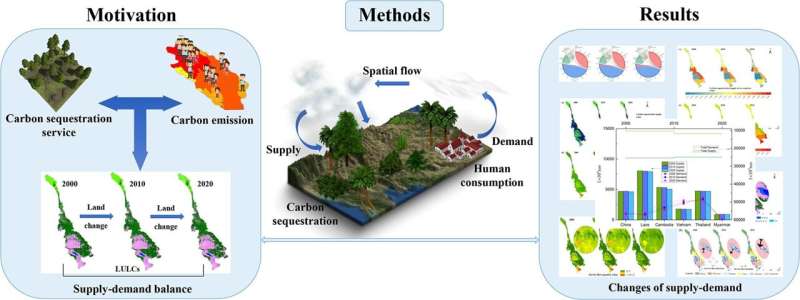This article has been reviewed according to Science X's editorial process and policies. Editors have highlighted the following attributes while ensuring the content's credibility:
fact-checked
peer-reviewed publication
trusted source
proofread
New evaluation framework helps quantify supply and demand of carbon sequestration services

The Lancang Mekong River Basin (LMRB) connects six countries in Southeast Asia. To support the ecological, economic and social sustainable development of the LMRB, low carbon management services need to be implemented in each country within the basin. However, there is still a lack of a science-based, effective assessment framework to identify the relationship between carbon sequestration services (CSS) supply–demand and flow.
In a study published in Ecological Indicators, researchers from the Xishuangbanna Tropical Botanical Garden (XTBG) of the Chinese Academy of Sciences and their collaborators explored the key challenges in implementing an effective carbon neutrality plan under global climate change, focusing on the supply-demand balance for CSS.
They developed a spatio-temporal assessment framework based on the Service Path Attribute Networks model to quantify the supply-demand balance of CSS under land use change.
By combining GIS technology and the spatial distribution characteristics of carbon sequestration services, the researchers first traced the flow path of CSS from supply areas to demand areas using spatial visualization technology, and then defined the path and quantity of CSS flow.
It was found that there was a significant imbalance between the supply and demand of carbon sequestration services in the Lancang-Mekong River Basin, which was manifested by a decrease in supply and an increase in demand. From 2000 to 2020, the total supply of CSS decreased by 1.14 million tons, while the total demand increased by 8.10 million tons.
The surplus area of CSS was mainly concentrated in forest areas, while the deficit areas were dominated by cultivated land and artificial surfaces. Significant changes have also occurred in the flow of carbon sequestration services. CSS mainly flowed from north to south, with higher CSS in Thailand and lower flow in China.
"Our novel assessment framework can be used as a standard decision support model for quantifying CSS supply and demand, rational land use planning, promoting international cooperation on carbon neutrality targets, and ensuring that carbon offset policies achieve regional low-carbon management and equitable development among regions," said Bai Yang of XTBG.
More information: Shiliang Yang et al, Exploring an assessment framework for the supply–demand balance of carbon sequestration services under land use change: Towards carbon strategy, Ecological Indicators (2024). DOI: 10.1016/j.ecolind.2024.112211
Journal information: Ecological Indicators
Provided by Chinese Academy of Sciences





















